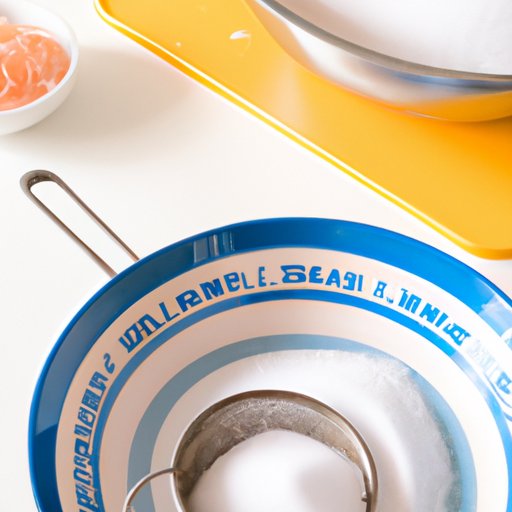
I. Introduction
Many baking enthusiasts have wondered whether or not powdered sugar can be a suitable substitute for granulated sugar. This article will explore the possibilities of substituting powdered sugar for granulated sugar, including measurement tricks, mixing techniques, and recipe substitutions. Aspiring bakers will find it useful to have a basic understanding of how substituting powdered sugar for granulated sugar can enhance their baking skills and results.
II. Baking 101: A Guide to Substituting Powdered Sugar for Granulated Sugar
Granulated sugar is coarse, sparkling white sugar commonly used in baking and sweetening beverages. Powdered sugar, also called confectioners’ sugar, has a finer texture and is made by grinding granulated sugar into a fine powder with added cornstarch. Substituting powdered sugar for granulated sugar requires some basic knowledge, measurement tricks, and mixing techniques. One cup of granulated sugar can be replaced with one and three-quarters cup of powdered sugar. The addition of cornstarch enhances its fine texture, which is perfect for light, fluffy cakes, and other desserts that require a smooth texture.
III. The Sweet Swap: Converting Granulated Sugar to Powdered Sugar in Your Recipes
Substituting powdered sugar for granulated sugar can change the texture, consistency, and sweetness level of baked goods. For best results, it is essential to know the correct conversion factors for powdered sugar and granulated sugar. One cup of granulated sugar can be converted to one and three-quarters cup of powdered sugar. This substitution is excellent for cookies, cakes, and frosting that require a smooth texture or mild sweetness. Recipes like bread, biscuits, and muffins are not ideal for the substitution of powdered sugar.
IV. Powdered Sugar vs. Granulated Sugar: Which One Works Best?
When deciding between powdered sugar vs. granulated sugar, it is crucial to consider the recipe and desired outcome. Powdered sugar has a smoother texture that is desirable for baked goods that require a fluffy texture and mild sweetness. Another advantage of powdered sugar is its ability to dissolve fast, making it ideal for glazes and frostings. However, granulated sugar works best in recipes that call for creaming, whipping, or recipes that require a crunchy or crispy texture.
V. How to Achieve Perfectly Sweetened Desserts with Powdered Sugar
When substituting powdered sugar for granulated sugar, it is crucial to know the correct measurement for each ingredient, as too much or too little can affect the recipe outcome. To measure powdered sugar, it is best to use a dry measuring cup with a flat surface. Fill the cup to the brim with powdered sugar, then level it using a flat spatula. Sift powdered sugar if necessary, especially for frosting/glazes, to improve smoothness.
VI. The Benefits and Drawbacks of Substituting Powdered Sugar for Granulated Sugar
Substituting powdered sugar for granulated sugar has several benefits, such as its ability to give baked goods a smoother texture, lighten the color, and provide a mild sweetness. However, it also has its drawbacks, such as being too sweet, creating a glaze that doesn’t set, or producing a grainy texture. It is essential to know which recipes work best with powdered sugar and which ones work best with granulated sugar.
VII. Confused in the Kitchen? Here’s When to Use Powdered Sugar instead of Granulated Sugar
Using powdered sugar instead of granulated sugar is ideal for recipes that call for a smooth texture or mild sweetness. For example, powdered sugar works well for frosting and glazes that require smooth textures and flavor. It is not suitable for recipes that require the development of air pockets, such as bread or muffins, which require granulated sugar’s presence and creaming ability.
VIII. Sugar Substitution: A Breakdown of Powdered Sugar and Granulated Sugar in Baking
The type of sugar used in baking can significantly affect the outcome of baked goods, and substitutions should be based on what the recipe calls for and what you desire in terms of texture, sweetness, and flavor. It is ideal to use a conversion chart when substituting powdered sugar for granulated sugar and vice versa. Sugar substitution is not only helpful in recipes but also practical when reducing sugar intake without compromising taste and texture.
IX. Conclusion
Substituting powdered sugar for granulated sugar in baking can result in a smoother texture, lighter color, and a mild sweetness. It is important to understand the conversion factors, how to measure, and the type of recipe that is best suited for each sugar type. Bakers are encouraged to try substituting powdered sugar in place of granulated sugar to enhance their baking skills and results. With just the right technique, powdered sugar can be an excellent substitute for granulated sugar in many recipes.





